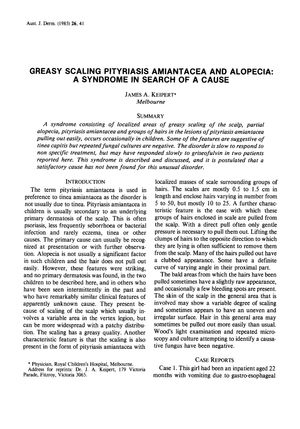TLDR The cause of the syndrome with scalp scaling and hair loss is unknown.
In 1985, a syndrome was described that involved localized areas of greasy scaling on the scalp, partial alopecia, and pityriasis amiantacea, with hair in the affected areas being easily pulled out, particularly in children. Although some symptoms were similar to tinea capitis, repeated fungal cultures yielded negative results. The condition was noted to be resistant to nonspecific treatments, but there were indications that griseofulvin may have led to slow improvement in two patients. The paper discussed this syndrome but concluded that a definitive cause had not yet been identified for this rare disorder.
23 citations
,
June 1977 in “Clinical and experimental dermatology” Pityriasis amiantacea is likely linked to eczema-related skin changes.
 6 citations
,
August 1991 in “Pediatric Clinics of North America”
6 citations
,
August 1991 in “Pediatric Clinics of North America” The document concludes that various hair and scalp disorders in children have specific treatments and proper diagnosis is essential.

Seborrheic dermatitis and dandruff are often treated with antifungal and anti-inflammatory medications, which can reduce symptoms and yeast growth on the scalp.
37 citations
,
January 2019 in “BioMed Research International” Itchy scalp is common, linked to various conditions, and hard to treat effectively.
 1 citations
,
October 2014
1 citations
,
October 2014 The document concludes that diagnosing and managing plaque psoriasis, particularly in sensitive areas, is challenging and requires careful differentiation from similar skin conditions.
 January 2013 in “Springer eBooks”
January 2013 in “Springer eBooks” Hair care products are important for appearance and self-esteem, and choosing the right ones can help maintain healthy hair.




